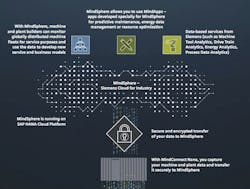A noticeable—and logical—shift is starting to take place in the automation industry. This shift is not a move away from the recent push for increased data collection as an enabler of Industrial Internet of Things (IIoT) and Industry 4.0 initiatives. Instead it reflects an increasing focus on the desired end result—how to create value from all this data—rather than on the data collection means to an end.
Comparing the current industrial IIoT trend to the dot-com technology transformation that took place in the late 1990s, Simon Davidoff, business manager of plant data services for Siemens, said that “we’re now talking more about outcomes rather than products. Rather than selling compressors, manufacturers are talking about selling compressed air; and instead of selling gas turbines, they’re selling power by the hour.”
This developing industrial business model shift away from pure product sales and toward services delivery “makes reliability more critical,” Davidoff said in his presentation at Siemens Automation Summit 2016. “Therefore, continuous monitoring is paramount.”
Fortunately, it’s cheap and effective to monitor numerous assets now because sensor technology and data storage prices have dropped so dramatically in recent years.
Beyond providing an array of automation technologies to create and log asset data, Siemens’ play in this technological and economic shift increasingly revolves around MindSphere, the company’s open cloud platform based on SAP's HANA Cloud platform. The MindSphere platform is designed to enable industrial users and OEMs to create data-driven services for their businesses through the use of open connection standards like OPC UA, plug-and-play connection with Siemens products, and a pay-per-use pricing model. Davidoff was quick to point out that the openness of MindSphere extends to non-Siemens devices as well.
To get plant data into MindSphere from non-Siemens devices, Siemens offers MindConnect Nano gateway to read data from non-Siemens industrial assets and pre-process it for transfer into MindSphere.
Getting started with MindSphere is a three-step process according to Florian Beil, Siemens' head of technical sales and mobilization data services. Step one is to connect assets to MindSphere using MindConnect Nano or direct plug-and-play if it's a Siemens product, and use MindSphere’s Fleet Manager service to configure the asset’s data model, data acquisition and connectivity. Step two involves running Fleet Manager to monitor the health of all assets configured in MindSphere. Step three is to use MindSphere’s Visual Analyzer service to access recommended asset optimization actions and address issues with specific users or user groups.
Beyond the initial Fleet Manager and Visual Analyzer services in MindSphere, analytical apps offered by Siemens via MindSphere include Machine Tool Analytics, Drive Train Analytics, Industrial Network Analytics, Process Event Analytics, Control Performance Analytics, Dynamic Process Optimization, and Energy Analytics.
Referencing Siemens' Data Train Analytics app, Davidoff noted that NASA has used it to create a predictive fault model for the gearboxes it uses. This service has “enabled predictive maintenance for NASA Flight Operations and has already caught two faults that could have created serious problems during flight,” Davidoff said.


